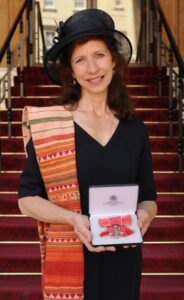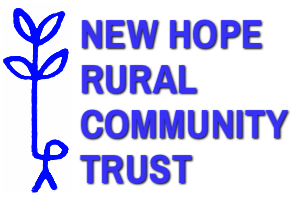
Name: Jill Ghanouni
Country: UK
Date of birth: 17th July 1959
Languages: English and German
Home: Southampton, UK
In October 2002 I returned to India. I was met at the airport by the son of a colleague who is the same age as
his Dad was when we last worked together! The following ten days were filled with comparisons of New
Hopes then and now, The next generation! The later visit was spent with the New Hope Rural Leprosy Trust whose director, Eliazar Rose, I had met on
the first visit.
The visit was superbly organised by my Trust colleagues in India and action packed as I was
asked at short notice to visit and I had only the half term as leave from job in the local junior school.
My very first visit at the age of 23 was one of those life altering adventures that makes the impressionable
young see the world differently from then onwards.
I got the address of a leprosy colony in 1981 from a nurse in London and it turned out to be the one Eliazar
was born in. He was working in this and others in Orissa and Andhra Pradesh. When I met him he suggested
that I visited a colony which had just been set up in Titilagarth in Orissa.
I spent six weeks learning basic patient care in a well established leprosy colony in Andhra Pradesh, moving
on for a planned quick visit to the brand new site at Titilagarth.
Monsoon rains washed away the railway bridge I’d crossed only hours before causing massive flooding and
the death of 6,000 people in an afternoon. My planned visit of a week or so became four and half months in
which time the number of patients soared from a handful to about 78 and the railway bridge was repaired. A
few months before I’d been a factory worker; now here was I seeming to many patients as if I was chief
medic. How many, I wonder, ever realised I was muddling through each day hoping that my basic care was a
slight improvement on the horrendous suffering and loss of everything they had because of leprosy.
Eventually surgeons and qualified health workers were able to get through to us.
They worked outdoors, amputating where necessary, stitching, diagnosing new cases, giving advice on how
to deliver our first baby – a breech birth at that. I was awe-struck at the hours they worked and the perfection
they expected of themselves and others.
News would come down the railway line of new cases coming to us: a mother dumped in the night beside
the track because she reeked too much from infection to stay on the train. We fetched her with an ox drawn
cart and brought her home to the colony. I remember that walk as if it were last night. The mother’s eyes
were glazed in semi-consciousness in the light of my lantern. The men guiding the cart chatted and cajoled
the ox to struggle through the massive ruts in the track. I looked up into the vast starry night and felt truly
thankful that we were not in a war zone. This was very little to deal with compared to doing the same job
with bombing and artillery fire all around you as of course so many others do.
Life slowly improved for the mother after losing the front half of both her feet and slowly being nursed back
to health and having customised upholstered sandals made for the remainder of her feet. Her husband came
to look for her and brought one of her children. My happiness for her being reunited with her husband was
tinged by my hatred for him dumping her.
At twenty three life’s challenges are very much put into perspective by the suffering of others on a grand
scale.
I returned to England at the end of the year too sick with hepatitis and malaria to take up the post of auxiliary
nurse that I’d hoped for.
It seemed a strange irony after the past 6 months work, but over the ensuing years I found other jobs, was
married and had two children. Within this period I registered a charitable trust in the UK. It was to be the
sister trust to the New Hope Rural Leprosy Trust in India.
This was the start of the New Hope Rural Community Trust [ http://www.newhopeuk.org/ ] – more broadly
named than ‘Leprosy Trust’ because we were serving a rural community with all the needs that impoverished
people have with nowhere else to go.
Thanks to so many people from all walks of life and age groups, their generosity and hard work the Trust has
raised many thousands of pounds over the past ten years.
Leprosy and polio victims have found new lives, not just through improved health and living conditions, but
through vocational training leading on to successful employment. The greatest recuperation can often be
restored dignity.
The generous support for New Hope’s work has meant that thousands of children have been immunised
against killer diseases, help for the victims of the 1999 cyclone, enabled orphan care for children of all ages
and physical/mental abilities and brought clean water supplies to areas where once there was none.
Throughout the past twenty years I’ve been a small part of New Hope’s work in the UK. I’ve been kept well
informed by mail and photos and word of mouth of it’s striding progress – but nothing prepared me for my
more recent visit!
Much of India looked the same. Its natural beauty aside, apart from technological advances, motorised
rickshaws and bottled sterilised water; the streets were very much as I remembered them. Some excellent
efforts to green up city centres have been implemented, but the scrawny dogs, the homeless elderly and the
livestock live and sleep in the roads. But take an eight hour train journey out of Vishakhapatnam north-east
to the small rural town of Muniguda in South Orissa, get away from the shanty area of the railway station,
about 25 minutes by vehicle to the New Hope Community Centre and you will believe you have reached
Paradise. I arrived late at night.
India is in its fourth year of drought and the electricity installed by New Hope to this area was off again.
By first light the full glory of the carefully thought out planting of dust-absorbing palms, vitamin bearing
plants and bushes, vegetables and exotic flowers became apparent. Butterflies the size of my hand and
parakeets sauntered between the trees. The dirt roads winding between buildings were being swept and the
home made litter bins (two gallon size cooking oil drums, , made safe, painted and fixed to poles every 200
yards along the road side) were being emptied.
The area is a wide valley with horizons of sugar loaf hills thick with forests volcanic in a forgotten era. I
spent a couple of days in the Centre discovering its management, facilities, dedicated workers and its
inhabitants. My mind kept flashing back to the sights and smells of 20 years ago. Could this be just a couple
of hours by train from the colony I had worked with then? Immaculate operating theatres, wards with ceiling
fans for summers that can see temperatures of 42 – 45 degrees C, running water and electricity. It was more
than I could have hoped for in my wildest dreams!
On the third day I was driven out to the Raghubari Centre – the reason for my visit this many years later. I
had been invited as the UK representative to see the work and forthcoming plans with Orissa’s most
impoverished – its tribal people. I am to be the liaison for a Community Fund Grant application to upgrade
the lives of the tribals of this area from subsistence level, and sometimes death by starvation, to self sufficiency.
It will be a massive project, but after my week’s stay with New Hope, I realise it is very achievable.
The distances and the terrain of India are hard to maintain in the memory. The one and a half hour drive to
the tiny health-cum-training-centre with a newly installed water pump (thank you to the children of Mount
Pleasant Junior School, Southampton) was a journey of massive ruts and no tarmac often brought to a halt by
herds of bony cattle. To my inexperienced eye it was a long way.
At the Raghubari Centre representatives of 13 tribal villages from those forested ‘sugar loaf’ hillsides had
come to meet me and through translators, tell me of their needs. They had walked barefoot a distance of 12
to 20 km, with only berries and nuts to eat on the way carrying babies or with young children. They would
return the same way that night and repeat the trek the next day for market day.
What is a long way? Despite many having no water supply, failed crops of lentil and rice and half their
children having died before the age of five, they decided unanimously that their number one need was
education for their children. They know that because they as parents are illiterate they are an easy target for
exploitation. If their children are able to learn how much in weight and money they are selling or spending in
the market place, they will not have to put up with being duped and cheated by traders willing to do this and
then to make tribal children debt inheritors. Over five years, schemes already under way are to be expanded.
Savings and credit schemes with emergency loan options are to be extended to the farthest settlements.
Health care training for all, free safe delivery kits for pregnant mothers and teachers to educate them relevant
to their life’s needs. Forest replanting where they’re stripping the hills of saplings for firewood because that’s
all there is to sell, is to be extended up the hillsides. There is a synergistic list of all they require and coordinators to ensure it can be achieved.
It is no exaggeration to say that New Hope is helping to change the face of India in its drive to let everyone
know “leprosy is curable – polio is preventable”. That it could be achieved in my lifetime is down to the
insight and dedication of New Hope India.

In 2014 Jill was made an MBE for her 30 years of voluntary services to the community in rural India.
